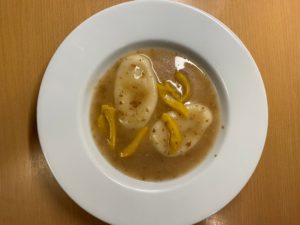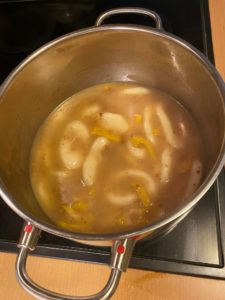Palitaw sa Latik
“Don’t terrorize me! “
 That was Pining, a good Pinoy friend of mine in Vienna, responding to my Messenger message with a picture of palitaw sa latik attached to it. Pining and I come from Plaridel, a town in Bulacan Province in the Philippines. Like me, there are times when she craves native delicacies particularly popular in our village. But, unlike me, she would seldom make an effort to satisfy her cravings. Too much work, she would say. So instead, she would use whatever was available in her kitchen to pass for an ingredient the recipe requires on rare occasions. Necessity is the mother of all inventions, after all.
That was Pining, a good Pinoy friend of mine in Vienna, responding to my Messenger message with a picture of palitaw sa latik attached to it. Pining and I come from Plaridel, a town in Bulacan Province in the Philippines. Like me, there are times when she craves native delicacies particularly popular in our village. But, unlike me, she would seldom make an effort to satisfy her cravings. Too much work, she would say. So instead, she would use whatever was available in her kitchen to pass for an ingredient the recipe requires on rare occasions. Necessity is the mother of all inventions, after all.
“It may not be how you do it but pede na (it will do) “is her consistent evaluation of what she cooks and serves on the table. She’s not big on making Filipino snacks or desserts. Therefore, she loves my ginataang bilo-bilo (sticky rice ball in coconut milk). She makes me feel good each time she tells me she cannot duplicate mine. But, again, different strokes for different folks would be my standard reply. Remember, even Nora Daza and Aling Charing, two famous Filipino chefs/cookbook authors, have different approaches to preparing the same recipe. They improvise. And if they can, Pining can.
“Kamoteng ube yan!” (They’re purple sweet potatoes!) Pining was quick to correct me one time we were at her place, and she served us sticky rice balls in coconut milk with something I thought were plums. How innovative, I told her. The color, the shape, and the size made me believe they were plums before I could even have a bite.
Again, unlike Pining, I get frustrated when an essential ingredient that makes or breaks my recipe is missing. I improvise at times, but I am not happy. I’d instead not cook, I thought, but there were times when I could be that desperate I don’t care settling for mediocre. And this applies to everything.
Take the palitaw. For the non-Tagalog speakers, Palitaw is a Filipino dessert made from glutinous rice flour. To make one, mix the flour with water to form a dough. I do my palitaw by cutting about a tablespoon of dough which I then mold into a small ball by rolling it between my palms until it is oval. I do not like them too flat, so I press my index finger in the middle of the dough the way I remember my mom would do it to make the palitaw resemble a small boat. Next, I do the same with the rest of the dough, giving them the same shape and size as much as possible, and drop them into boiling water until they float, hence the name palitaw. Litaw in Tagalog, in this case, is to surface. So I soak them in cold water and drain, roll them in grated fresh coconut. And sprinkle them with sugar (I prefer muscovado sugar) mixed with ground toasted sesame seeds.
That is easy. The palitaw sa latik (palitaw in coconut syrup) is another story. The process is pretty the same, but there’s more to it than what you think. My aunt used to make them, and I haven’t seen anyone in our family make them since my aunt died. And that was many years ago. So I googled how to prepare them, but the recipe was not how my aunt would make it. However, someone from our town sure knows how to make the one I crave—the palitaw sa latik. Together with ginataang pinipig (glutinous rice flakes in coconut milk), it is a constant reminder of the rice harvest season in my hometown in November. It is the month when folks would be busy pounding green glutinous rice called pinipig in time for Pasalamat (Thanksgiving). So, where turkey is associated with Thanksgiving in America, it is pinipig in my hometown. Our ginataang pinipig is prepared together with young coconut meat strings, taro root crop, and chico. Chico is a tropical fruit that, when ripe, has a sweet smell of beer. You soak the pinipig in coconut milk with sugar, set it aside for about half an hour until it is tender. Then, the powerful sweet aroma of coconut milk, yam, and chico fills the room.
I was staring at the essential ingredients for the palitaw sa latik, not knowing where to begin, when I heard that familiar sound for incoming messages on my cp. It was Anita, a long-lost friend from a neighboring barangay (village) in my hometown. We found one another again two years ago after seeing each other, and that was more than half a century later. Then, we were in our teens, both sweet and juicy—like the latik sa palitaw. Now we are more like latak (sediment) of old coconut milk, but not rancid.
“Hello, is Vienna part of Europe?” Anita asked.
“You’re kidding me. Part of Europe? Of course not! Vienna is a city in China! Why?” Anita noticed the sarcasm and laughed.
“You see, I have this virtual boyfriend from Shetfield in England who asked me to visit him.”
“SHET! You mean Sheffield?”
Laughter. Could be, she said. She has to check. “Yes, Sheffield. “
The man from Shetfield does not like traveling by plane. Therefore he seems to have little knowledge of other countries, Anita told me. Maybe you can say to him Vienna is in China; it was tempting to say to her.
“Do you think they make palitaw sa latik in Shetfield?” I lost her there. I was in stitches. She does not know, but she knows how—she said after recovering from a brief shock.
 And thus, the palitaw sa latik online tutorial began. Unfortunately, Anita had to interrupt the lesson at one point because her virtual boyfriend was online but would get back to me soon.
And thus, the palitaw sa latik online tutorial began. Unfortunately, Anita had to interrupt the lesson at one point because her virtual boyfriend was online but would get back to me soon.
Shet! That was me in exasperation after I poured the coconut milk into the pan to boil. She forgot to tell me if it was ok to stir it, so I let the milk boil until it curdled. Meanwhile, the palitaw pieces were floating by then in the pot of boiling water, and I didn’t know if I should take them out and drain. So I left them in the casserole until Anita video-called again.
“Shetfield!” I exclaimed when she told me I should boil the palitaw with the sugar and then add the toasted coconut milk curd. I looked at my palitaw getting fat—obese was more like it—floating in the boiling water, overcooked. Then add the shredded pieces of langka, too. That was Anita, again, her afterthought. For that extra kick. Yes, Virginia, Anita uses jackfruit, which is langka in our language.
I was beginning to doubt her. My aunt used pandan leaves or anis for flavor in my childhood palitaw; the taste is implanted in my mind forever. However, Anita’s does not sound like the one I remember getting as a child. So I wondered how her concoction would pass my expectations significantly when she said ground toasted sesame seeds could enhance the flavor.
Perhaps not precisely how I remember the palitaw sa latik of my youth. It was different but good. My neighbor and official food taster, Marylin, and her Austrian husband liked it. I could now say that when the time comes, Anita could make her Shetfield boyfriend happy.
Shet, Marylin, and her husband even said yes to a second serving.
Shet! I wish l live closer!!!
Wait until Lockdown is over. Or dare defy the protocols :)